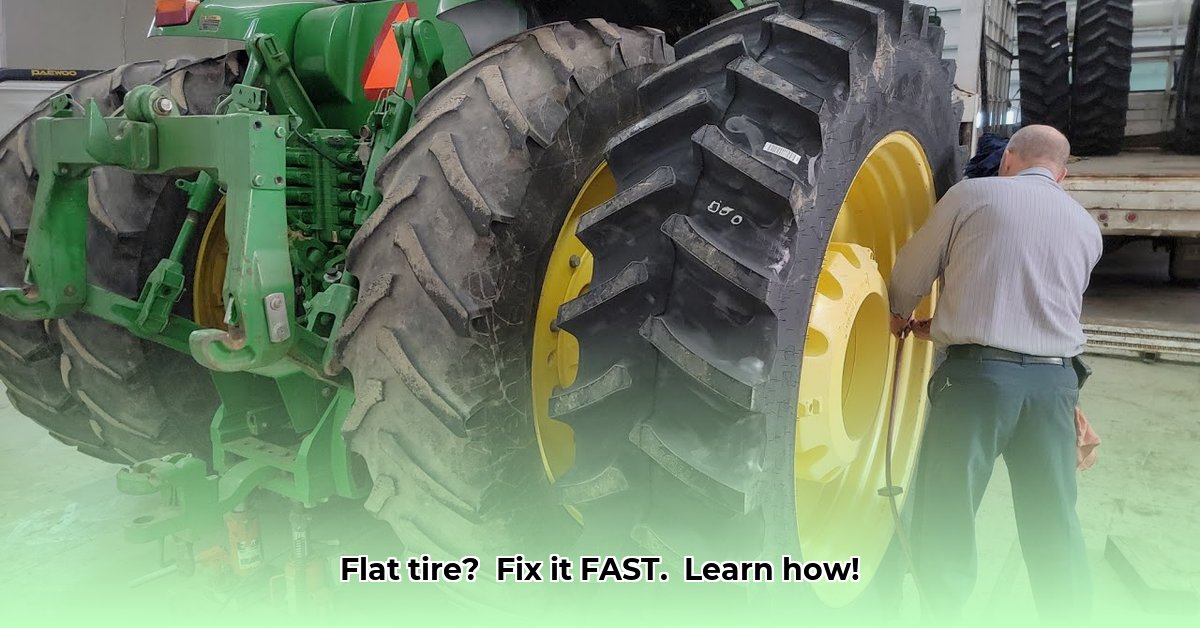
Changing a tractor tire can seem intimidating, but with careful preparation and the right technique, it's a manageable task. This guide provides a step-by-step process to ensure you get back to work quickly and safely. Remember, safety is paramount when working with heavy machinery and high-pressure tires. For more information on proper tire pressure, check out this helpful resource on tractor tire pressure.
Gear Up: Essential Tools and Safety Precautions
Before you begin, gather the necessary tools and equipment. This will streamline the process and prevent delays. Never compromise on safety.
- Heavy-duty Tractor Jack: Rated for your tractor's weight (check your owner's manual). Using an inadequate jack is extremely dangerous.
- Lug Wrench: A long-handled, sturdy lug wrench is essential. A breaker bar might be needed for stubborn lug nuts.
- Wheel Chocks: Crucial for preventing the tractor from rolling; never skip this step.
- Tire Irons (or Levers): For prying the tire's bead (the edge) off the rim.
- Gloves: Heavy-duty work gloves protect your hands from cuts and abrasions.
- Safety Glasses or Goggles: Protect your eyes from flying debris.
- Air Compressor (Optional but Recommended): Significantly simplifies tire inflation.
- Penetrating Oil: Useful for loosening stubborn lug nuts or spindle nuts.
Preparing for Tire Change: A Safe and Efficient Approach
- Choose a Level Surface: Park your tractor on a stable, level surface. Uneven ground can compromise stability and safety.
- Secure the Tractor: Engage the parking brake and firmly wedge wheel chocks against the wheels opposite the flat tire. This prevents accidental movement.
- Deflate the Tire: Completely deflate the flat tire to make it easier to handle.
Removing the Old Tire: A Detailed Procedure
- Jacking Up the Tractor: Position the jack under the designated jacking point (consult your owner's manual). Slowly raise the tractor until the flat tire is off the ground. For added safety, consider using jack stands once the tractor is partially lifted.
- Loosen Lug Nuts: Use your lug wrench to loosen the lug nuts slightly before fully raising the tractor. This is much easier to do while the wheel is still partially on the ground.
- Remove the Wheel Assembly: Once the tractor is fully lifted and secured (using jack stands if possible), carefully unscrew the lug nuts and remove the wheel assembly. Be prepared; the wheel might be heavy.
Installing the New Tire: A Step-by-Step Guide
- Mount the New Tire: Carefully align the new tire onto the wheel studs. Ensure all studs are correctly engaged.
- Hand-Tighten Lug Nuts: Hand-tighten the lug nuts to hold the wheel in place.
- Lower the Tractor: Slowly lower the tractor using the jack. Maintain control at all times.
- Tighten Lug Nuts: Once the wheel is on the ground, fully tighten the lug nuts using a star pattern (opposite nuts first). This ensures even pressure distribution.
Inflate and Inspect: Final Steps for a Secure Fit
- Connect Air Hose: If using an air compressor, securely attach the hose to the tire valve.
- Inflate Gradually: Inflate the tire slowly to the recommended PSI (pounds per square inch), as indicated on the tire's sidewall. Overinflation can be dangerous.
- Inspect for Leaks: After inflation, check carefully for any leaks around the tire bead.
Troubleshooting Common Issues: Solutions and Preventative Measures
- Stuck Lug Nuts: Apply penetrating oil and let it sit for at least 30 minutes before attempting to loosen them. If they remain stuck, use a breaker bar. If these methods fail, seek professional assistance.
- Difficult Tire Removal: Use multiple tire irons/levers, working your way around the tire's bead. Avoid damaging the rim.
- Tire Bead Won't Seat: This often requires a specialized tire bead seater tool. Professional help might be necessary.
Remember, your tractor's owner's manual is your best resource for specific instructions and safety recommendations. If you're uncomfortable performing any step, seek assistance from a qualified mechanic. Regular tire inspections and preventative maintenance help prevent unexpected breakdowns and ensure your safety.